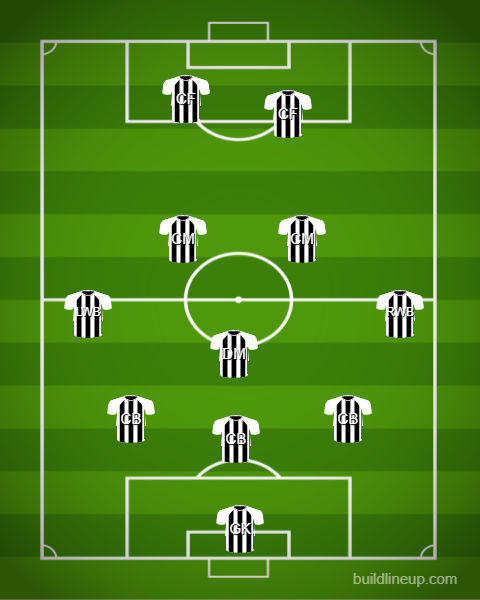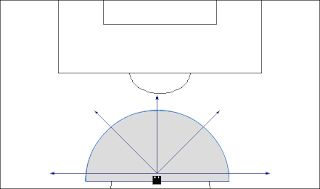Tactical Preview: St Mirren 2021/22
Tactical Preview: St Mirren 2021/22
The Premier Sports League Cup has somewhat replaced, if not fully eradicated, pre-season friendlies, so it might not be wise to draw many conclusions from them. Yet Jim Goodwin seems practically wedded to the 3-1-4-2 formation that has been used to in all of our competitive matches thus far, meaning a closer look as to how we're going to play makes sense. I'm going to primarily focus on the 2-0 victory against Partick Thistle, since there are no clips on Wyscout for the Dunfermline game, and playing a rotated team against the part-timers of Stenhousemuir won't be quite as insightful.
Let's start with the defence where, unsurprisingly considering we're playing a system with 3 CBs, Jim Goodwin has us set up to be defensively compact in the middle of the pitch. This means we forego defending the wings quite so vigorously. As an aside, we weren't pressing with any coordinated intensity, instead preferring the man closest to the ball to plough a lone furrow and run towards the opponent - perhaps the warm temperatures help explain this.
The benefits of the 3-1-4-2 formation have been apparent so far this group stage; the caveats about quality of opposition notwithstanding, our only concession was a late consolation for Stenhousemuir after we collectively switched off. We didn't concede a single counterattack against Thistle (although they didn't concede one to us either apparently, which probably sums up the nature of the encounter well) and restricted them to 21 positional attacks - defined by Wyscout as any open play attack which isn't a counterattack and, for context, we managed 43 of them ourselves. Jak Alnwick had very little to do, facing just 2 shots on target.
An area for concern, however, was Partick Thistle's big chance with Brian Graham in the first half:
The immediate beginning isn't very encouraging in and of itself - Alan Power being overworked at the start of the clip will be returned to later - however, the disarray which ensues following the pass by Bannigan was alarming. Dunne and Shaughnessy have followed Graham and Rudden respectively, temporarily swapping them round. Dunne ends up the wrong side of the ball, while Shaughnessy can't overcommit since doing so would leave Rudden wide open for the simplest of square passes.
Marcus Fraser, in case you're wondering, is caught in two minds. He can see the danger unfolding, although Jay Henderson has been caught the wrong side of a very intelligent run from deep and shouts for cover. Fraser blocks off the pass out wide but, ultimately, the far bigger threat is centrally. Here's a very crude approximation of how the play looked tactically:
Happily, the above example is very much exception to the rule "thou shalt not pass through this St Mirren team". This is very handy, as the unlikely source of Steve McClaren explains, in a nugget of wisdom plucked from a Michael Cox article. There are essentially only three ways to beat an opposition defence: you can go around them, you can go through them, or you can go over them. On that note, Partick Thistle had 13 crosses on Sunday, yet only 1 has been classed by Wyscout as accurate. As was alluded to earlier, St Mirren were perfectly content with ceding the wings while defending. The priority for Saints was fortifying the central areas where the opposition are always going to pose the most goalscoring threat. Take a look at the video below:
Scott Tanser tucks in to keep us compact, leaving his opposite number Ross MacIver with a reasonable amount of space on the right flank. He swings in a cross, however St Mirren have 7 players in their defensive shape and all centre backs ready to attack the ball. It's an easy enough ball to deal with but crosses and finishes of the required quality to score a goal from that angle are very few and far between.
In case you think I'm cherrypicking an example where we were set defensively, let's take a look at an instance of Partick progressing up the field after we lose the ball while on the attack:
While this is a dangerous transition - after Brophy is dispossessed, he is out of the game along with Main, Kiltie, McGrath, and Henderson - St Mirren still retain a lot of security. Poor Alan Power is outnumbered in the midfield admittedly, however with the quantity of central defenders we have, reducing opponents to speculative long shots such as that should be chalked about as a tactical success.
Admittedly, we will be playing far better players than the Thistle lads this season but the use of Tanser here to create a de facto back 4 shows that the discipline we need is still present. Changing from our pragmatic style to a more cavalier approach might be more entertaining, however the video above shows playing to our strengths and maintaining this level of organisation is key to improving on last year.
Earlier I mentioned Alan Power was the defensive midfielder ahead of a McGrath-Kiltie tandem. While I'm still perfectly happy that Greg Kiltie has joined the team this summer, I would prefer to see Ethan Erhahon in the starting XI instead. The clips already featured thus far in the article have tended to show Power being either outnumbered, isolated, or both. Furthermore, this match showed that while Jamie McGrath needs to be further up the field. Despite undoubtedly proving he is a classy operator - even chosen as Man of the Match on Premier Sports - his best moments were little turns or flicks too far from goal to truly impact the game. I would play them asymmetrically, meaning Erhahon would be slightly deeper on the left, ensuring McGrath on the right can advance a few yards closer to the attacking third.
If we take the above as a theoretical, abstract ideal of how we shape up at the beginning of possession: our outer centrebacks, particularly Marcus Fraser, have been happy to advance given the opportunity; our wingbacks, especially Scott Tanser, look to burst forward while hugging the touchline; and our strikers occupy their direct opponents defensively. The role of Erhahon and McGrath, in the way I would like us to utilise them, can occupy the area between the touchline and the centre of the field: otherwise known, in "football hipster" terms, as the half-space (the two red lines along the outer 18 yard box line and the 'D'.
The importance of this space is detailed exquisitely by current Borussia Monchengladbach assistant coach Rene Maric in this article. I have nabbed the photos below from there to illustrate my point:
Playing midfielders in a flat 2-1 or 1-2 centrally can lead to predictable vertical or horizontal passes. To improve our attacking threat (and, despite my unusual levels of optimism going into the season, I do fear we'll continue to be goal-shy as usual in the top division) this domination of the half-space will be important. Borrowing a quote directly from the Rene Maric piece, he states "The range of the diagonal pass works against the opponent’s movements much better... This is because the ball can go further and faster in addition to the nature of the more stable dynamics when the ball arrives at its destination. This also allows for a greater range from the diagonal passing game."
The half-space is also a more threatening zone than the flanks. This is partly because of space - the touchline forces ball and player to go fewer available directions - and also simply because it is harder to score or create from out wide. The ball (or player) has further to travel, meaning the time the ball (or player) takes to get from A to B is longer, which affords the opponents more time to reorganise and prevent goals or goalscoring opportunities.
Moving neatly on, our modus operandi in attack thus far has been to prioritise getting our wingbacks in threatening crossing areas and flooding the box with targets for them to aim at. Scott Tanser has been putting in some scintillating deliveries and can count himself very unlucky to not have an assist thus far. Wyscout have him down as 8 successful crosses out of 11 (see below) giving him an outrageously high 73% crossing accuracy. While that number isn't sustainable over a season, our strikers can expect quality service from him.
We can also expect plenty of the following ingredients to our attacking play:
- Playing out from the back; quickly, if possible, due to the disorganisation of opponents.
- Availability of the wingbacks prioritised, as they are key to carrying the ball further up the pitch.
- A striker dropping deep/running wide to help create overloads.
- A shot from outside the box if nothing else is on.






Brilliant analysis and really interesting read!!!
ReplyDeleteCheers Buddie :)
DeleteExcellent analysis.
ReplyDeleteThanks Scott :)
DeleteMaybe send this to the manager.
ReplyDeleteVery food article Lewis, really enjoyed reading it.
ReplyDeleteThanks very much mate 🙂
Delete